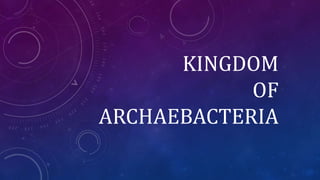
Kingdom of Archaebacteria: The Oldest Organisms on Earth
- 2. ARCHAEBACTERIA? • The oldest organism living on Earth. They are unicellular prokaryotes microbes without cell nucleus and any other membrane-bound organelles in their cells and belong to the kingdom, Archaea. They were first discovered in 1977 by Carl Woose and George E. Fox and classified as bacteria. Most archaebacteria appear like bacteria, when observed under the microscope. However, they are quite different from bacteria and eukaryotes.
- 3. WHERE CAN WE FIND THEM? •Archaebacterial are found in very harsh conditions such as in the volcanic vents or at the bottom of the sea. They can easily survive in such extreme environment as sea vents releasing sulfide-rich gases, hot springs, or boiling mud around volcanoes.
- 6. WAIT, THERE’S MORE! •Under the kingdom Archaea, archebacteria are classified into the following phyla
- 7. • Phylum Euryaarchaeota: This is the most studied division of archaea, and mostly includes methanogens and halophiles • Phylum Crenarchaeota: It includes thermophiles, hyperthermophiles and thermoacidophiles. These archebacteria are mostly found in the marine environment. • Phylum Korarchaeota: This division consists of hyperthermophiles found in high temperature hydrothermal environment.
- 8. • Phylum Thaumarchaeota: This phylum includes ammonia- oxidizing archaea, as well as those with unknown energy metablolism. • Phylum Nanoarchaeota: This phylum has a single representative member named Nanoarchaeum equitans. This unusual archebacterium is an obligate symbiont of another archaea belonging to the genus Ignicoccus.
- 9. WHAT ARE THE IMPORTANCE OF THIS? Archaebacteria are important, almost indispensable, for the following reasons: • They have phylogenetic importance that helps in studying their homology and establish their phylogeny. • Their ability to tolerate extreme conditions helps researchers learn about the climatic conditions, environment and their survival on ancient earth.
- 10. • Methanogens can grow in biogas fermentors and decompose cow dung into methane gas as a by-product. Thus, they are used for production of domestic gas for cooking. • Organisms like Methanobacterium ruminantium are present in the guts of ruminating animals, helping them digest the cellulose. • Poor ores of molybdenum are microbial leached using Sulfolobus. • Archaebacteria are also used to synthesize thermophilic enzymes, restriction enzymes and are also used as biosensors.
- 11. • Archaebacteria have an important role in many chemical cycles, like carbon cycle, nitrogen cycle, sulfur cycle, etc. • Due to their extremophilic nature, archaebacteria have proven to be of great help in the field of Bioechnology, by helping in the production of enzymes that work at very high temperatures, as well as in the production of some antibiotics.
- 12. • The characteristics of Archaebacteria kingdom prove that life can exist anywhere, under any condition. The mere existence of these extremophiles gives us hope. Maybe we will discover something on the other planets yet!